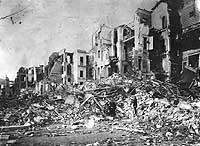
Before dawn on 28 December 1908 a powerful earthquake and tsunami struck south Italy, devastating the Sicilian city of Messina. The death toll was terrible, with estimates of those killed running up to two hundred thousand. Other nations' navies sent men and ships to help Italian authorities with recovery and relief work. Among these were the British, whose large Mediterranean Fleet soon had two battleships, five cruisers and a destroyer at the scene. The Russians, whose training squadron was also in the vicinity, provided men from several battleships, cruisers and gunboats. While digging through the remains of collapsed buildings to rescue survivors and locate the bodies of the dead, some of the Russian sailors lost their own lives when an aftershock buried them in rubble.
The U.S. Navy, whose presence in the Mediterranean was minimal at the time, initially dispatched the station ship (and former luxury yacht) Scorpion from Constantinople, Turkey. She left there on 31 December 1908, arrived at Messina on 3 January and remained there until the 8th, when she began her return voyage to Turkish waters.
More U.S. Navy ships came later. When the earthquake struck, the U.S. Atlantic Fleet's battleship force was steaming up the Red Sea toward the Suez Canal, nearing the end of its passage from the Far East during its great World cruise. The fleet's Commander in Chief, Rear Admiral Charles S. Sperry, ordered the supply ship Culgoa, carrying hundreds of tons of food, to head for the disaster zone as soon as she could get through the canal. She left Port Said, Egypt on 4 January, arrived at Messina on the 8th and was there or at Naples until 15 January. While Culgoa was on her way, six Navy surgeons from the battleships, as well as medical supplies, were put aboard the tender Yankton (another converted yacht) and, on 5 January, set off from Port Said, arriving at the stricken city on the 9th and remaining until the 14th.
They were followed by Sperry's flagship, the battleship Connecticut, which called at Messina on 9 January, while en route to Naples. All, or nearly all, of the photographs presented below come from the collection of one of her officers. The battleship Illinois arrived on 14 January to help recover the bodies of U.S. Consul Cheney and his wife from beneath the ruins. This mission, involving hazardous tunneling through the ruined Consulate building, was soon completed. Illinois sailed the next day for Valetta, Malta, where she rejoined her division.
A large quantity of supplies, originally intended for Sperry's fleet, along with a hastily loaded prefabricated hospital left the United States at the end of December on board the Navy supply ship Celtic, arriving at Naples on 19 January 1909 and then taken to Messina. Celtic and her crew were in the Sicily-Naples area for about two months, distributing urgently needed supplies to towns along the Sicilian coast, erecting temporary shelters and otherwise helping the quake's survivors. When Celtic left to return home on 21 March, Assistant Surgeon Martin Donelson remained in Sicily with a detachment to construct housing and provide further medical assistance. Donelson was ordered back to the United States on 10 June 1909, bringing to completion more than five months of Sicilian earthquake relief work by U.S. Navy personnel.
This page features all the views we have concerning the 28 December 1908 earthquake at Messina, Sicily, and subsequent relief efforts.
| If you want higher resolution reproductions than the Online Library's digital images, see: How to Obtain Photographic Reproductions. |
Click on the small photograph to prompt a larger view of the same image.
NOTES:
| If you want higher resolution reproductions than the Online Library's digital images, see: How to Obtain Photographic Reproductions. |
Page made 30 October 2008
Coding updated 13 April 2009